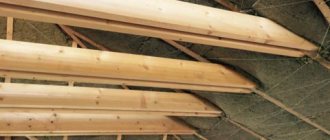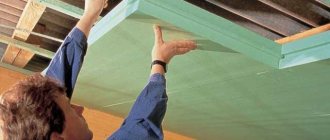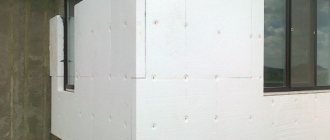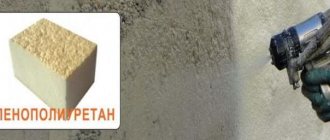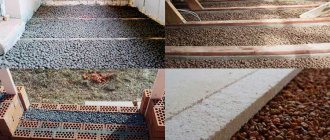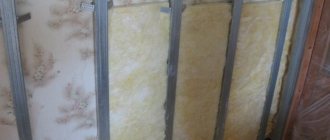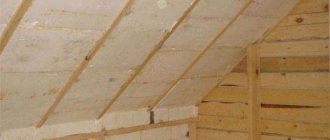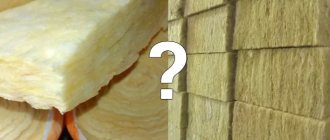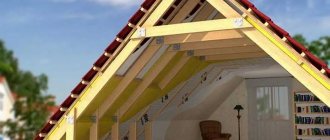Owners of private houses with basement insulation from the inside can supplement the useful space of their home not only with a spacious basement. If desired, they can also equip an attic - a room under the roof (essentially the same attic, only landscaped).
Insulated attic from the inside
If various workshops are usually located in the basement, then the attic often serves as another bedroom. However, in order for it to be fully used as a living space during the cold season, it is necessary to take care of insulation. And the best solution to solve this issue is PPU - or sprayed polyurethane foam.
1Features of attic insulation
Installing insulation for the attic from the inside, as well as insulating a well from concrete rings, is a much more complex and time-consuming task than insulating an ordinary room. The difficulty lies in the following factors:
- lack of horizontal overlap on top - that is, insulation will have to be done directly along the inner surface of the roof, which usually has a triangular shape; low temperature in the attic in winter; moisture may get inside, onto the surface of the insulation (this happens when the roof is damaged) - which not every insulator can withstand.
For these reasons, the use of most other materials, if possible, will be a very, very difficult task.
By the way, regarding the relevance of the process itself: thermal insulation of the attic from the inside is needed not only in cases where it is planned to equip a living space. Even if you are not going to use the attic in any way, it still needs to be insulated.
The reason is simple: the lack of insulation leads to the fact that the temperature above the ceiling (that is, in the attic) in winter will tend to the street temperature. In addition, it is quite possible that it will also be damp inside - since the roof covering often has leaks (and if not, they can appear over time).
Spraying polyurethane foam between the joists from the inside
As a result, moisture from natural precipitation will seep into the attic, spoiling its microclimate.
Dampness, in turn, can lead to the appearance of fungus and mold, and they can appear not only in the attic itself, but also from the inside, in the living quarters of the second floor. This problem is especially relevant for owners of wooden houses with polystyrene foam - after all, wood is most “afraid” of contact with water.
Advantages of polyurethane foam
PPU spraying technology is the cheapest among all types of insulation
Guarantee against leakage of overlap joints and fasteners
Fire safety G 1. Eco-friendly (certificate of contact with water).
Corrosion and rotting bypassed the polyurethane foam. Even rodents are indifferent to this material.
The service life of polyurethane foam is more than 50 years!
Temperature range from -200 to +200 degrees Celsius. Neither severe winter nor terrible heat are scary for PPU.
The main advantage of polyurethane foam is its environmental friendliness. During its entire service life, it does not emit any chemicals. Widely used in the food industry, footwear, sleep and leisure products. Including for children as it is hypoallergenic!
2About the material and its features
Now it’s important to touch on the properties and characteristics of the polyurethane foam itself. The use of sprayed insulation is a relatively new word for our market, but this technology quickly began to replace outdated mineral wool and foam insulation.
By the way, every person has seen polyurethane foam in one of its forms more than once - this is ordinary foam rubber used for padding upholstered furniture and entrance doors. Foam rubber is the so-called elastic polyurethane foam, and is not suitable as insulation.
Another form of polyurethane foam is rigid.
These products are presented in the form of slabs, indistinguishable in appearance from extruded polystyrene foam. However, as mentioned above, it is very difficult to insulate an attic from the inside with slab insulators, so we will only consider spraying technology.
2.1 Characteristics and advantages of the insulator
First of all, you need to pay attention to the quality characteristics of polyurethane foam. The parameters are as follows:
- thermal conductivity coefficient like PSB S 35: about 0.025-0.03 W/mK (about one and a half times lower than that of mineral wool and foam insulation); density: from 30 to 200 kg/m³; service life: up to 40 years (this figure can differ - different companies promise different durability).
In fact, it is now difficult to say exactly how long sprayed polyurethane foam will effectively last - since it began to be used in our country relatively recently, and the “age” of most objects insulated with it does not exceed 4-5 years. However, the conditions carried out in laboratories prove that it actually begins to lose its properties after more than a dozen years.
The process of insulating the attic from the inside using polyurethane foam
Typically, the density of the material for insulating residential buildings is about 60-80 kg/m³, however, if necessary, this indicator can be changed. This is done by changing the proportions when creating the polyurethane foam itself - the material is prepared right at the work site, by mixing two components.
It goes without saying that the higher the density, the more effective the insulator and the higher its price. You can save money in the following way: initially, a layer of dense polyurethane foam is applied to the surface of the roof from the inside - it will better protect the structure from possible contact with moisture. Then, a less dense (but cheap) composition is sprayed onto it.
Another – third – layer of glass wool and mineral wool is sprayed on top of it, with the same density as the first. Thus, a kind of “pie” is obtained: with a denser insulator around the edges and a less dense one inside.
Regarding flammability: the material is classified as non-flammable.
When in contact with an open fire, it smolders, but does not spread the flame. However, there is a downside: when the threshold of +500 degrees is exceeded, it begins to release compounds dangerous to humans. However, this is typical for most other heat insulators, so this point cannot be called a significant drawback.
But among the significant advantages of polyurethane foam are the following properties:
- resistance to moisture, and absolute - even with frequent exposure to water, the material will not react in any way, will not begin to deteriorate or mold; the material is not interesting to rodents or insects; in normal condition, the material does not harm humans in any way (unlike, for example, mineral wool) ;lightness - which is very important for both the roof and the attic floor; in addition to retaining heat, polyurethane foam also insulates sounds quite well - which is very important for the roof (for example, this will reduce the noise from rain drumming on the roof).
If necessary, the properties of the insulator can be further improved, as when insulating a house with mineral wool under siding - for this, components can be added to its composition during preparation that will increase the resistance of the material to high temperatures.
What is construction polyurethane foam?
In comparison with elastic compounds of polyols foamed with air and/or carbon dioxide (foam rubber), construction polyurethane foam is a rigid material with a density of 30 - 150 kg/m³. However, it is not rigidity that is the main difference between insulating polyurethane foam and foam rubber, but the structure of its pores. In construction foam, up to 98% of the pores are closed, so the material does not absorb water and conducts heat poorly (due to the gas filling of the chambers - the pores).
Polyurethane foam - a new generation of insulation
Polyurethane foam, sold in spray cans, also belongs to insulating polyurethane foams, but its percentage of closed pores is lower (about 80%). In general, the higher this indicator, the higher the energy efficiency of the insulation. Polyurethane foam has the lowest thermal conductivity coefficient among all insulators currently used in construction. For the best two-component systems, the parameter value does not exceed 0.019 - 0.021 W/m*K. This is 30% less than samples of high-quality extruded polystyrene foam (EPS), which have a coefficient of 0.028 W/m*K.
Polyurethane foam is a material with stable properties. Its characteristics have not changed for many decades. However, it is destroyed when exposed to ultraviolet radiation, so it requires protection from it. The minimum required protection can be achieved with conventional painting.
2.3 Spraying technology
Insulating an attic with polyurethane foam probably has only one significant drawback: using such insulation with your own hands is impossible for most people. The reason is the high cost of special equipment - the installation with which polyurethane foam is applied to the surface.
The simplest compact model costs approximately $2000-2500 (the same cost for insulating the blind area around the house), so purchasing it for treating one building is unprofitable. In addition, the operation of such an installation requires some experience, and the correct preparation of the insulation itself is also not a task for an inexperienced person.
Let's consider the sequence of work stages:
- The attic room is completely emptied of contents. Insulated surfaces are completely cleaned of finishing materials, thermal insulation, dirt, dust, mold. If possible, detected leaks, cracks, holes in the roof must be repaired. Logs are installed on the insulated surface. Polyurethane foam is prepared on site. Between the logs The composition is sprayed. After the first layer has completely hardened, the next ones are applied if necessary. After applying the required number of layers along the joists, the facing material is installed and further finishing is carried out.
As you can see, in addition to the insulation, the thermal insulation layer does not contain a waterproofing layer - it is simply not necessary, due to its resistance to moisture. This reduces both time, effort and money for work.
Features of the device kit for carrying insulation
Application of polyurethane foam to the surface requires the use of special equipment. Before purchasing it, you must make sure that all components are available. These include:
- cylinders for forming foam with liquid inside (2 pieces);
- a spray gun from which foam will be released;
- hoses connecting the gun and cylinders;
- interchangeable nozzles for guns of various modifications;
- component keys necessary for assembling equipment;
- technical lubricant.
Since coating polyurethane foam surfaces is considered a difficult task, and special equipment is expensive, special services have to be involved in the process. If there is an appropriate sprayer unit on the farm, the main thing is to connect it correctly.
Gun variant used for polyurethane foam Source onlinetrade.ru
2.5About the advantages and disadvantages of technology
The technology for applying insulation discussed above may seem unfamiliar to the reader. Not surprising - after all, for those who have not encountered thermal insulation work, the idea is probably limited to gluing foam plastic or unwinding a roll of mineral wool.
In fact, this method is many times simpler, but at the same time more effective and convenient than the same polystyrene foam or mineral wool. The list of obvious advantages of the technology includes:
- the use of a thin layer of insulation (due to minimal thermal conductivity) - which is very important from the inside; no need to level the surface being treated; no need to create a complex multi-layer “pie”; minimal time for surface treatment (on average, in 6-8 working hours, 1 person can cover about 100 m²); monolithic insulation (that is, the absence of any seams); covering structures of any shape.
The first point is a fairly significant advantage. Indeed, when working from the inside, the main problem is the loss of free space, which can reach considerable values. For example, if you insulate the floor using expanded clay, be prepared to raise it by about 20-30 cm, thereby making the room smaller.
When insulating walls with polystyrene foam, you will have to lose about another 10-15 cm. Polyurethane foam is much more economical in this regard - the effective insulation layer is approximately 3-5 cm.
The second and third points will be appreciated by those who have tried to independently insulate any surface using polystyrene foam or mineral wool. Compared to spraying, this is a much more labor-intensive and lengthy process that requires not only time, but also attention.
If there is even a slight difference in height, the foam will no longer lie flat. Well, you have to work with mineral wool wearing gloves, a respirator and goggles.
It goes without saying that saving time is also a significant advantage. When creating a floor screed, you would have to wait several days until it hardens. And simply creating a heat-insulating “pie” is also not a quick procedure.
When it is necessary to insulate the attic from the inside, most homeowners choose mineral wool or expanded polystyrene (foam). The fact is that these are the most common types of insulation in Russia and, moreover, they can be installed independently.
At any construction market or Do-It-Yourself format store (Obi, Leroy Merlin, etc.) they will always offer to buy both mineral wool and polystyrene foam. But this does not mean at all that mineral wool and sheet insulation made from foam polystyrene are the best and most effective for attic insulation. Polyurethane foam is superior to them in terms of characteristics, and even more so in terms of manufacturability.
Advice from professionals
PPU insulation is considered a complex technology. It is better to entrust the work to hired specialists. If you decide to master this “art” on your own, you should listen to the advice of professionals:
- When mixing polyurethane foam with water, the ratio is 1:1.
- If the working mixture has darkened, the proportions are not maintained correctly. The properties of the insulation will deteriorate.
- When insulating in the middle zone of the attic, the thickness of the polyurethane foam is applied at least 15 cm.
- Insulation is best done in warm weather, when the air temperature is above + 10 ° C.
- During spraying, moderate humidity is created in the attic. Excess moisture is not allowed. The insulation can peel off from the surface or harden with large air bubbles.
- During operation of spraying equipment, ventilation is provided in the attic.
- Spray foam from a gun, moving from bottom to top. The nozzle is removed from the insulated surface at a distance of 50 cm.
- In one pass, a layer of the required thickness is immediately sprayed. You cannot use a gun to return to areas of foam that have not hardened.
Upon completion of work, the equipment is washed. If polyurethane foam accidentally sticks to the body, carefully remove it with a solvent.
How to choose material for attic insulation
Properly selected insulation is half the success in insulating an attic roof. The second half of the success of the idea comes from the professionalism of those involved in insulating the attic from the inside. There are a number of criteria that should be taken into account when selecting thermal insulation material:
- Thermal conductivity. It should be minimal, ideally no more than 0.05 W/m2. Hygroscopicity. This parameter should also be kept to the possible minimum. The less the material absorbs moisture, the better. Weight. Choose insulation with low weight and density to eliminate the load on the roof when installing thermal insulation. Safety. Opt for insulation that does not support the combustion process. Tendency to deformation. It is also better to exclude it: do not buy thin, soft rolled materials, which over time will lose their shape, settle, exposing the upper part of the roof. Frost resistance. Must be high, because the insulation will have to take on temperature changes. Service life of attic roof insulation. The more, the better - this is obvious .Thickness.Calculated taking into account the climatic characteristics of the region, the thickness of the roofing pie and walls of the house, as well as a number of other factors known to professionals.
Comparison of polyurethane foam with analogues
| PPU | Styrofoam | Ecowool | Minvata | |
| Life time | More than 50 years | No more than 20 years | No more than 15 years | About 30 years |
| Environmental friendliness | 100% eco-friendly | Chemical | Eco-friendly | Chemical |
| Installation | Spraying without installation work | Additional materials and tools required | It is necessary to create a frame | It is necessary to create a frame |
| Thermal conductivity | 0.02 W/mK | 0,03 — 0,045 | 0,03 — 0,037 | 0.03 - 0.042 W/mK |
| Density | from 9 to 45 kg/m3 | from 11 to 40 kg/m3 | from 26 to 95 kg/m3 | from 20 to 200 kg/m3 |
| Hygroscopicity | Low vapor permeability | Does not allow moisture to pass through | Low vapor permeability | Low moisture resistance |
| Fire resistance | High | Fire hazardous | Doesn't burn, but smolders | Eat |
| Flaws | Destroyed by ultraviolet radiation (but a layer of regular paint will protect against exposure) | Fragile, increased flammability, low sound insulation | Absorbs moisture and cannot be used in wet areas. Decreases in volume over time | Absorbs moisture, favored by rodents, susceptible to the development of fungi and bacteria |
| Expenses | Only for material | Low cost, expensive delivery, long installation, requires polyurethane foam | Inexpensive material, requires frames, professional installation with wet application | For delivery, material, frames and fasteners, installation |
| Pest resistance | Yes | Yes | Yes | No |
So why is polyurethane foam used less often for attic insulation?
Largely because polyurethane foam is difficult to lay on your own. This is because initially polyurethane foam consists of 2 liquid components. Moreover, as a rule, it is supplied in 200 liter barrels.
Two barrels weigh approximately half a ton. When an ordinary person finds out what polyurethane foam is in its raw form, he prefers “not to mess with polyurethane foam” and use what is “clearer and simpler” for attic roof insulation, i.e.
mineral wool or PSBS. And this is a mistake, the understanding of which will come later. Moreover, you will have to pay for this mistake in all subsequent years.
In fact, there is nothing supernatural about insulating an attic roof with polyurethane foam. To do this, you will need a special machine for applying polyurethane foam.
The task of the device is to pump raw polyurethane foam from barrels, dose it in the required ratio, and feed it through hoses into a special gun, where the two liquids meet and a chemical reaction begins. After which the air-liquid mixture is sprayed onto the insulated surface.
Therefore, it is problematic to carry out attic roof insulation with polyurethane foam on your own. It is necessary to hire specially trained people or buy such an installation yourself.
Why not, if in addition to insulating the attic from the inside, you can apply polyurethane foam to the walls, roof, foundation, floor, ceiling, etc.
etc. You can completely insulate your own home.
And it will be cheaper than ordering insulation work from the outside. You can then start your own small business and insulate the attics of others. We recommend watching the presentation from the conference on PPU in Novosibirsk about the possibilities of using polyurethane foam.
But, if it seems difficult to buy a machine for spraying polyurethane foam and master this type of work, then a person chooses an accessible and, by the way, cheap (but not at all the best!) method. In other words, buy mineral wool or polystyrene foam and lay it yourself.
Cheaper is cheaper, but you are not going to live in such a house for a year or 3.
PPU will be more expensive if compared momentarily. But, if we compare in perspective, taking into account heating costs, then in three years the costs for polyurethane foam and mineral wool will be equal, and then the one who insulated with mineral wool will go into a severe minus, and those who insulated with polyurethane foam will actually save. Therefore, before choosing this or that insulation, it is recommended to arm yourself with at least minimal knowledge about the resistance of building materials to heat transfer.
Of course, we can be called biased in our desire to offer polyurethane foam for insulating the attic from the inside.
Still, the SovTech company is the number 1 seller in Siberia of this type of gas-filled plastic. But the point is not even that we are promoting polyurethane foam, in the end, if your attic is not insulated with our polyurethane foam, then we will survive it. It’s not us who have to live in the house and it’s not us who have to pay for heating in the winter.
Simply, our many years of experience in construction work in Siberia shows that we cannot save on thermal insulation. Savings at the construction stage of a ruble will come out to 10 rubles in expenses later, during operation.
Before choosing PUR foam, we naturally used both mineral wool and polystyrene foam (and are now ready to use it if the customer insists). Therefore we can compare. The following outlines the main disadvantages of insulating an attic roof with mineral wool, when compared with polyurethane foam.
Why insulate the attic?
High-quality attic insulation provides the home owner with a number of tangible benefits:
An additional room can be arranged under the roof.
- Heating costs are reduced in winter. It has been proven that most of the heat escapes into the atmosphere through the roof.
- It will be possible to live in the house all year round.
- The rafter system will be protected from moisture contained in warm air. The wooden parts of the roof will retain their quality longer.
- Not every attic can be turned into a living room. If the height of the roof along the ridge is below 2.5 meters, then the attic will only serve as a utility room.
Traditional attic insulation
Disadvantages of attic insulation with mineral wool:
Firstly, it is placed in the cells between the rafters.
This means that it can be laid indented from the rafters, at an angle or vertically. Over time, the insulation sheets will sink slightly, shrink and a void will appear, i.e.
place to freeze. In order not to overpay for heating, you will have to additionally insulate the attic or re-do the roofing. In short, save money and plan your time.
Secondly, the required insulation thickness is 200 mm, plus wind protection, plus vapor barrier, plus padding of bars. If you look at this method of insulating an attic roof as a whole, it is obvious that there is an increase in costs for materials and work, and with questionable quality at the end.
Thirdly, laying insulation on part of the floor often leads to the suction of cold air under the attic baseboard, and builders often do not cover the end of the horizontal insulation. And as a result, problems arise such as cold below the wall, high condensation, air movement from the floor to the ceiling, additional condensation on the ceiling and increased humidity.
All such “delights” can be avoided if the attic insulation is carried out with liquid polyurethane foam.
Table of contents:
- Requirements for materials for attic insulation - making a choice
- Why is it best to insulate an attic with polyurethane foam?
- How to insulate an attic using polyurethane foam
- Which PPU attic insulation to choose?
- Step-by-step insulation of the attic
- Insulation of the attic of multi-storey buildings
It is known that cold air sinks down, therefore, by not letting it through the attic, you can make the entire house warmer, reducing heat loss by 25-30%.
An insulated attic can be used for various purposes, increasing the usable area. Since modern insulation not only protects from the cold, but also dampens noise, the rooms will become quieter; for example, when it rains, you won’t hear drops falling on the roof.
Attic roof insulation with polyurethane foam
Stages of insulating an attic roof from inside the room
When insulating an attic with polyurethane foam, the thickness of the foam should be 10 cm. As a rule, this is the value obtained as a result of thermal engineering calculations for the West Siberian Plain. It is better to spray polyurethane foam between the rafters on the hemmed ceiling, and then attach waterproofing sheets to the rafters on top.
It is better not to spray polyurethane foam on the attic roof, as it changes its size depending on the season (winter-summer).
Due to the precipitating suspension of material, application work is better done outdoors than indoors. When applied correctly, a homogeneous, approximately even surface of the foam is obtained on top of the ceiling covering. The layer is no thinner than 10 cm, thickening towards the rafters for better insulation and greater adhesion (sticking) to the rafters.
In terms of flammability, foam burns worse than wood. But the sheathing and rafters are wooden... On the topic of flammability of polyurethane foam and other insulation materials, read on this page sovte.ru.
Polyurethane foam for attic insulation is also good because, in addition to thermal insulation, it performs the functions of vapor barrier, wind protection and sound insulation. PPU does not have cold bridges through cracks or fasteners, because...
There are no cracks or fasteners. PUR foam is applied in a uniform layer from above, along a vertical wall and goes horizontal to the wall of the building. In the summer it is cool in such an attic, and in the winter it is warm.
How much does it cost to insulate an attic space with polyurethane foam?
The cost of attic insulation directly depends on the roof surface area. It is logical that insulating an attic using polyurethane foam in a small country house will cost an order of magnitude less than in a large country house. The final cost of insulation is calculated not only from the price of the material, but also from the cost of equipment, if you decide to do this work yourself. An alternative option is to order a service for attic insulation with polyurethane foam from a specialized company. This service has a fixed cost, which depends on the area of the attic. When calculating the cost, the density level of the material is also taken into account.
Vapor barrier
The fact is that the insulation has low thermal conductivity, while actively absorbing moisture and “breathing”. If there is no vapor barrier, warm indoor air passes through the insulation and condenses in the area of contact with the roofing pie. Condensation in the form of water droplets penetrates the insulation - hence dampness, mold, and the loss of the insulator’s ability to retain heat.
If you use mineral wool for insulation, aluminum foil or already foil insulation will help solve the problem of vapor barrier in the attic.
Pros of using PPU
Insulation of PPU floors allows you to get excellent strengthening results. Thanks to the positive properties of the material, the structure becomes stronger, and its elements are protected from exposure to various environments. The material also has a high level of sound insulation.
Another important advantage of PPU is cost minimization. For example, its transportation becomes much cheaper. Substances are contained in liquid form. When they are released from the container to the outside, they interact with the air and foam is formed. The material hardens very quickly, which allows you to create a reliable protective layer.
If extruded polystyrene foam is used for insulation, 400 sq. m. you will need to use about 20 cubic meters of EPP. When using polyurethane foam you will need only 16. The savings are about 20%.
In addition, the slabs are inconvenient to use when it is necessary to insulate the ceiling. Such protection from the cold will not be very reliable. Often the roof is a structure with a large number of projections and differences. When using polyurethane foam, it is possible to insulate structures of any complexity. The substance will easily penetrate into any place, and then form a protective layer that can last more than 50 years.
Another property of polyurethane foam is that it is thermally inert. Many materials have the ability to retain heat in summer and not eliminate cold in winter. Polyurethane foam ensures preservation of coolness in summer and warmth during frosty periods. For this reason it is quite popular.
Important! The use of polyurethane foam allows you to additionally waterproof the floor. This allows you to create reliable protection against moisture.
Thanks to the use of polyurethane foam, rot and mold do not appear on the wooden parts of the structure. This is due to the low water absorption coefficient. Even immersed in water, polyurethane foam will absorb no more than 3% moisture in 24 hours. When using polyurethane foam, work is carried out very quickly. Using a sprayer, a layer of material is applied to the roof in the amount needed for a specific area.
Waterproofing
The purpose of waterproofing the outside of the insulation is to prevent moisture from entering the insulation in the event of a roof leak. For this purpose, it is better to use special membranes with vapor-proof properties. Such membranes are more expensive than conventional waterproofing, but in fact they will repeatedly justify the costs.
By the way, closed-cell polyurethane foam lacks the ability to absorb and retain moisture, which makes it an excellent solution for attic insulation. Adhering tightly to the attic ceiling material, polyurethane foam does not leave gaps or voids into which moisture could enter.
So, let's summarize. Proper attic insulation is based, figuratively speaking, on “three pillars”:
- thermal insulationwaterproofingvapor barriers
Sprayed polyurethane foam solves all three problems simultaneously, which makes it so far the most practical material for insulating an attic roof.
We will help you select and calculate the amount of material, taking into account the area and type of your attic, and give recommendations for use. We will calculate the cost of services for thermal insulation of the attic roof and walls using our specialists.
Some nuances when insulating
I would like to highlight some points that some do not consider necessary to take into account. But they are important because they guarantee your safety and the best quality of insulation. It all starts with the little things, so we recommend that you stick to what is written below.
Firstly, we are talking about overalls for insulating the attic. The worker performing insulation with polyurethane foam must protect himself from contact with the skin, eyes or respiratory organs of the chemical. To do this, use a special suit, gloves, a respirator and safety glasses. If there is no special suit, then you can use another type of clothing with the same qualities.
Secondly, it concerns the mixing of polyurethane foam components. You need to adjust everything so that the two components of polyurethane foam are mixed in an ideal 1:1 ratio. In addition, thorough mixing is important. If the ratio is not observed, the performance of the insulation is reduced.
These rules for attic insulation are simple, but quite important. Don’t neglect them, and then you will fully feel the beauty of polyurethane foam insulation.
